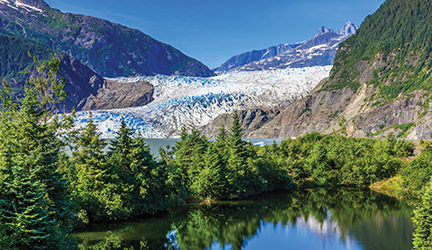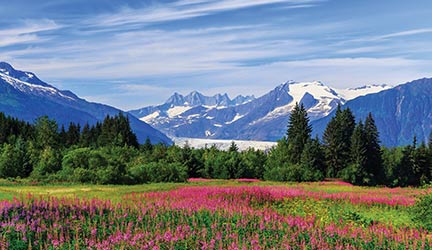Before Alaska was known for glaciers, grizzlies, and grandeur, it was a land of golden dreams. At the tail end of the 19th century, tens of thousands of hopeful prospectors braved the wilderness in pursuit of fortune, reshaping the culture and landscape of this northern frontier.
Today, you can sail through these historic waters aboard an Alaska cruise with American Cruise Lines, where stories of pickaxes and perseverance still echo through the mountains and towns.
The Setting Before the Gold Rush
In 1867, the United States purchased Alaska from Russia for $7.2 million—a move ridiculed by many as “Seward’s Folly.” But the land was anything but foolish. Long before it was on America’s radar, Alaska was home to thriving Indigenous cultures who understood its natural wealth. The Tlingit, Haida, Inupiat, Yup’ik, and others navigated its waters, fished its rivers, and lived in harmony. They were also aware of the minerals beneath their feet, with oral histories and trade patterns hinting at the presence of gold long before prospectors arrived.
For years, the U.S. government had little interest in Alaska beyond its strategic location and natural beauty. But as whispers of mineral resources turned to rumors of striking gold, the narrative changed.
Early Alaskan Gold Discoveries
Gold was first officially reported in Alaska in the 1870s, with small finds near Sitka and Wrangell sparking interest among adventurous miners and entrepreneurs. By 1872, miners in southeastern Alaska were making modest strikes—just enough to stir curiosity.
Sitka, a port visited on our Alaskan Explorer itinerary, was one of the early gold boomtowns. Once the capital of Russian America, Sitka had the infrastructure, shipping access, and rough charm to support prospectors who set up camps in the surrounding hills. Though these finds didn’t create a stampede, they laid the groundwork for what was to come—hinting that Alaska’s real treasure was buried deeper.
The Klondike Connection and the Stampede North (1897–1898)
The real rush began with a shout from across the border. In 1896, gold was discovered in the Klondike region of Canada’s Yukon Territory. When word reached the West Coast in 1897, it sparked a frenzy. More than 100,000 stampeders set their sights on the north—and Alaska became the gateway.
On our Alaska Inside Passage cruise, guests visit Skagway, the most famous port of the Klondike rush. A once-sleepy harbor town, Skagway exploded overnight. Saloons, boarding houses, and supply stores lined its muddy streets, and the Chilkoot and White Pass Trails became grueling paths for those brave—or desperate—enough to carry their supplies to the goldfields. Nearby Dyea served a similar role before fading into obscurity. Alaska's towns thrived on the back of these dreamers, not from digging gold, but from outfitting those who would.
Life in Alaska During the Gold Rush
Gold may have brought hope, but life in Alaska’s mining towns was far from easy. Settlements were often muddy, lawless, and hastily built. Tents, rough-hewn cabins, and makeshift saloons lined the streets, with little infrastructure and less stability.
For miners, the work was backbreaking and uncertain. Many arrived too late, underprepared, or ill-informed. Illness, injury, and hunger were common, and only a lucky few ever struck it rich.
One of the most significant discoveries came from a team that included Indigenous insight and partnership. In 1896, George Carmack, traveling with his brother-in-law Skookum Jim Mason and nephew Dawson Charlie, discovered gold along Rabbit Creek—later renamed Bonanza Creek—near the Klondike River. Their find ignited the stampede to the Yukon and forever changed the region. Skookum Jim and Dawson Charlie, members of the Tagish First Nation, played a vital role in this historic moment—though their contributions were often downplayed in early retellings.
Women in frontier towns also made their mark. Among them, Belinda Mulrooney stood out. She arrived in Dawson City with just a few hundred dollars and built a hotel empire, eventually becoming one of the richest women in the Yukon. From selling ice cream and hot water to miners passing through to founding the Grand Forks Hotel, her sharp instincts and fearless ambition made her a legend.
Major Gold Discoveries in Alaska
As the Klondike rush faded, Alaska revealed its own golden secrets. In 1899, gold was found on the beaches of Nome—literally scattered in the sand. Miners scooped it up with shovels and frying pans, and a new wave of fortune-seekers flooded in.
In 1902, Felix Pedro struck gold near Fairbanks, launching yet another rush that turned the tiny outpost into a bustling hub. These later discoveries proved Alaska’s long-term mineral promise, sparking the development of railroads, banks, and schools, and forever shifting the region’s trajectory.
Following the Path of the Gold Rush on Alaska’s Waterways
The Gold Rush may have ended, but its legacy still flows through Alaska’s rivers and ports. Aboard an Alaska cruise with American Cruise Lines, you’ll trace the same waterways once filled with steamships loaded with cargo and gold-seekers. Skagway, Sitka, and Juneau now welcome travelers not with picks and pans, but with stories, museums, and mountain views that stretch into history.
Each port offers a chance to stand where stampeders once stood, to walk streets built on gold, and to see how Alaska’s identity was forged—not just by those who found fortune, but by all who stayed behind.
Retracing a Golden Chapter
The Alaska Gold Rush was a brief but brilliant blaze in history—full of grit, gamble, and change. It built towns, disrupted lives, launched legends, and left behind stories etched into the land itself. Step aboard with American Cruise Lines and experience this history for yourself.


